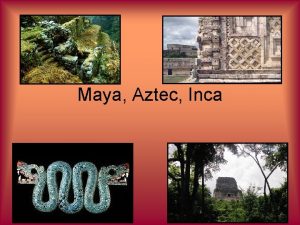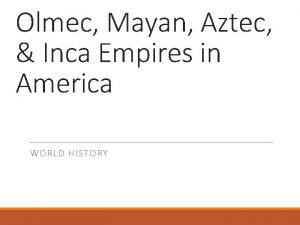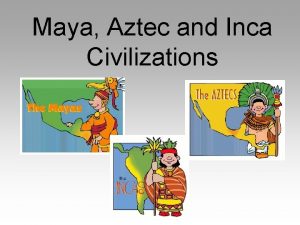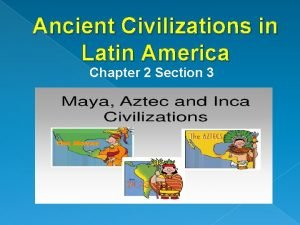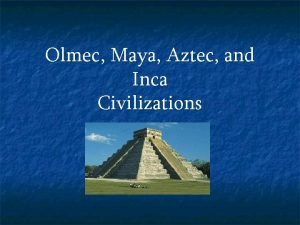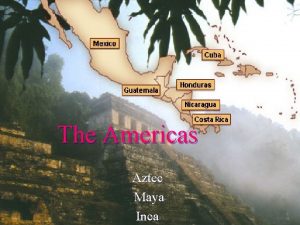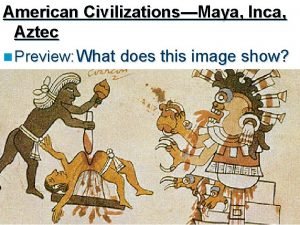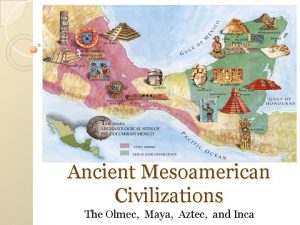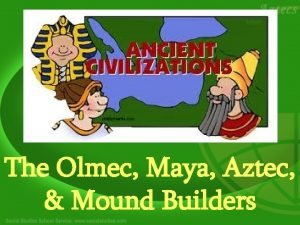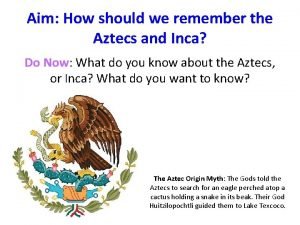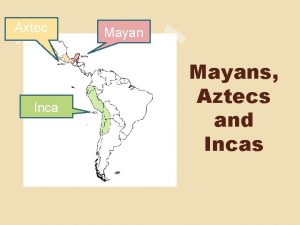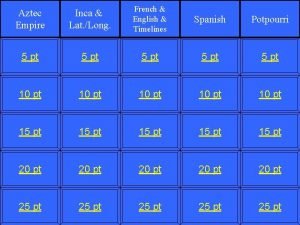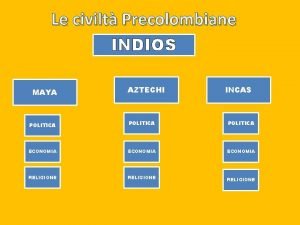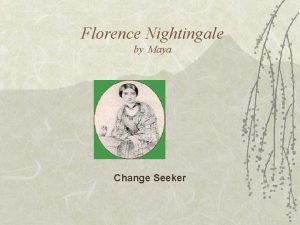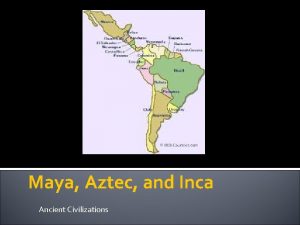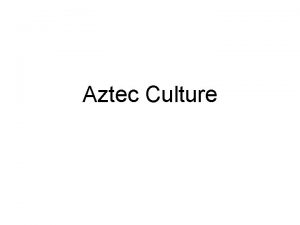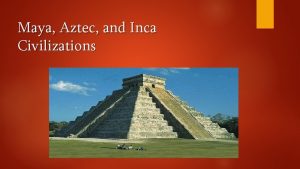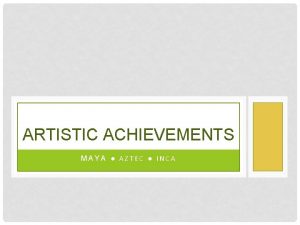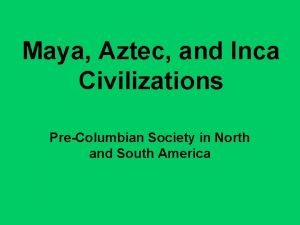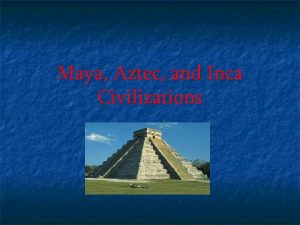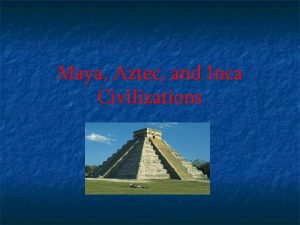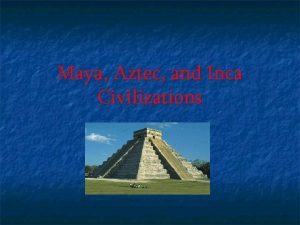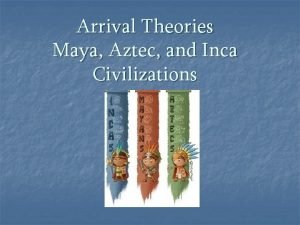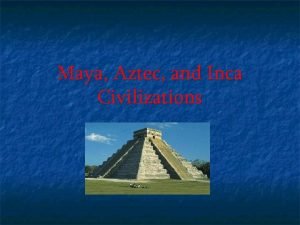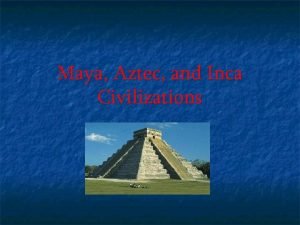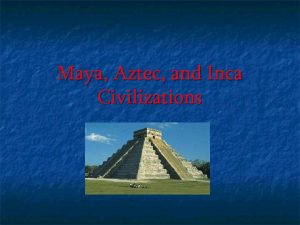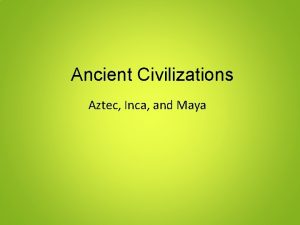Maya Aztec and Inca Civilizations Essential Question What

















- Slides: 17

Maya, Aztec and Inca Civilizations

Essential Question What are the cultural achievements of the Ancient Maya?


Timeline Incas 1200 -1500 CE 1600 CE 0 Maya 300 -900 CE Aztecs 1100 -1521 CE

The Mayas • What geographical features did the Mayan lands include? • Southern Mexico (Yucatan Peninsula), Belize, § Gulf of Mexico to Caribbean Sea Guatemala, El § Rugged highlands/swamps Salvador and Honduras

The Mayas • What did the Mayans look like? • Short with straight, black hair, painted bodies, tattoos, crossed eyes, flattened foreheads

• Why did Mayas tie objects from their infants’ foreheads? • To encourage their eyes to cross • Why did some Mayas tie boards to their children’s heads? • To flatten their foreheads – this was a sign of beauty in their culture The Mayas

The Mayas • What did early Mayas eat? • They fished and they grew maize (corn), beans, squash, peppers, avocados, and papayas

• Pre-Classic: 2, 500 BC to AD 250 – fishing villages/learned to plant crops • Classic Era: AD 250 – AD 900 – built cities, pyramid temples, developed advanced math and astronomy and writing • Post-Classic Era: AD 900 – 1500 – Mayas left their great cities and scattered through out countryside – not sure why – we will discuss possible reasons The Mayan Eras

• Largest city - Tikal (in present day Guatemala) – 100, 000+ people The Maya - Tikal

• 2 nd Largest city – Copán (in present day Honduras) • The Great Staircase: 30 ft wide, 63 steps, picture writing covers each step The Maya – Copan

• Chichen Itza – Large observatory tower used by ancient astronomers and Well of Sacrifice

Mayan Writing • Borrowed a writing from Olmecs • Developed a system of writing using pictures (glyphs) and symbols

Mayan Books • Made paper by pounding fibers from bark of ficus tree into pulp and glued it together with tree sap • When the paper dried they coated it with white lime • A Mayan book is called a codex • Fiber paper/deer hide for covers • Why did the Spanish destroy Mayan books? • Why do you think they thought they were evil?

Mayan Math + = 7 + 3 = 10 = 18 - 7 = 11 + + = 3 + 12 + 0 - 5 = 10 = + 7 + 2 - 9 = 0

Mayan Calendar • The Mayan priest used their knowledge of astronomy and math to develop two accurate calendars • One was sacred (religious), the other was for planning • The Mayan Calendar – solar year of 365 days. – divided into 18 months of 20 days each, followed by a five-day period that was highly unlucky. – Did the Mayan’s predicted that the world would end on December 21, 2012?

The Great Mystery of the Maya • Around AD 850/900 the Mayas suddenly left their cities and were scattered throughout the countryside – Why? ? • Some theories for why they did this include: • Natural Disasters – earthquake, hurricane, drought • Disease • Crop failures/famine (no plow, did not develop new agriculture methods) • Peasant rebellion against the priests and nobles who ruled the cities • Invaders - Toltecs
 Maya, aztec, inca map
Maya, aztec, inca map Aztec inca and maya map
Aztec inca and maya map Maya aztec and inca
Maya aztec and inca Maya aztec and inca civilization chart answers
Maya aztec and inca civilization chart answers Aztec olmec maya and inca empires
Aztec olmec maya and inca empires Aztec inca and maya map
Aztec inca and maya map Lesson 1 the peoples of north america and mesoamerica
Lesson 1 the peoples of north america and mesoamerica Aztec and inca venn diagram
Aztec and inca venn diagram Where did the olmec live
Where did the olmec live Olmec maya aztec inca timeline
Olmec maya aztec inca timeline Aim aztec
Aim aztec Aztec tlachtli
Aztec tlachtli Aztec mayan inca timeline
Aztec mayan inca timeline Inca vs maya
Inca vs maya Maya inca aztechi differenze
Maya inca aztechi differenze Il trattato di tordesillas
Il trattato di tordesillas Nightingale health
Nightingale health Level 3 questions
Level 3 questions
